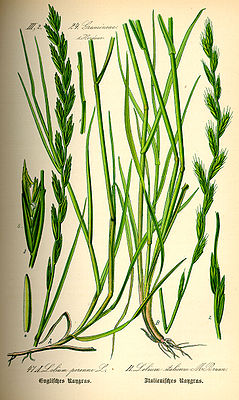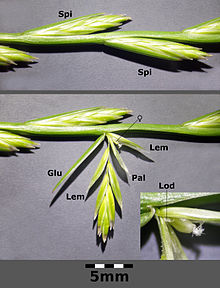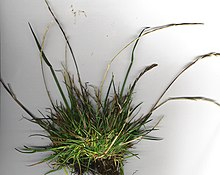German ryegrass
| German ryegrass | ||||||||||||
|---|---|---|---|---|---|---|---|---|---|---|---|---|

German ryegrass ( Lolium perenne ) (left) |
||||||||||||
| Systematics | ||||||||||||
|
||||||||||||
| Scientific name | ||||||||||||
| Lolium perenne | ||||||||||||
| L. |
The German ryegrass , also called perennial lole ( Lolium perenne ), is a perennial plant species from the sweet grass family (Poaceae). It is a productive and largely insensitive grass both in pasture and meadow use, which is used in almost every type of grassland. It is commercially available in numerous varieties.
In accordance with its widespread use, a number of other names are in use for this grass in German-speaking countries: Perennial ryegrass, English ryegrass, English ryegrass, permanent lole or spelled husk .

description
The German ryegrass grows in clumps with numerous sterile leaf shoots. New daughter plants sprout from the rootstocks via short runners (lawn formation). The dark green, shiny leaves are two to four millimeters wide and up to 20 centimeters long. They are rough on the upper side due to numerous longitudinal grooves, smooth on the underside and with a distinct keel in the middle.
The smooth stalks of the German ryegrass usually rise in a curve and reach a height of up to 70 centimeters. In the area of the ear , they are meandered in an S-shape. In each bay (alternately with a clear distance to each other) there is a spikelet , with the narrow side towards the stalk (unlike the couch grass, Elymus repens , in which the spikelets are transverse). The whole ear therefore looks flat and slender. The ear part of the stalk is up to 30 centimeters long. The spikelets consist of two to ten flowers. They are up to twenty millimeters long. All husks are without awns .
The flowering period lasts from May to autumn.
The number of chromosomes is 2n = 14.
ecology
The German ryegrass is a perennial, evergreen, lawn-forming hemicryptophyte . It is windy of the "long-dust thread type", weakly feminine, self-sterile and a frequent hay fever pathogen. The flowering period lasts from May to autumn.
The fruits are caryopses with (unfurled) cover and palea as a unit of expansion (husk fruits that act like biological capsules). In addition, there is human spread (also as cultural refugees), random spread through grass-eaters, as well as water adhesion and the spread of treads. Fruit ripening is from August to October. The caryopses are light germs .
Vegetative reproduction occurs through short runners , which connect the clumpy growing plants with each other like a network.
Similar species
The also common Italian ryegrass ( Lolium multiflorum ) is usually annual. The lemmas of its flowers usually have an awn up to 15 millimeters long. While the leaves of Lolium perenne simply sprout folded and have a keel on the underside, the leaves of Lolium multiflorum sprout into a spiral and therefore have no keel. Lolium multiflorum has significantly wider leaves (up to ten millimeters wide).
The two species of flax-lolch ( Lolium remotum ) and tumbler-lolch ( Lolium temulentum ) are very rare.
Occurrence and location
The German ryegrass is originally found in Macaronesia , in Europe to Siberia and the Himalayas as well as in North Africa. But in many other countries it is a neophyte.
The German ryegrass prefers nitrogen-rich, even superficially compacted soils of medium humidity in climatically favorable locations. There it is one of the most common grasses in meadows and pastures. But it also occurs wildly on grassy surfaces and along roadsides. This grass is a bit sensitive to frost, which can easily lead to damage in colder or higher altitudes, e.g. B. to gaps in the lawn. It originally comes from Europe, but is now widespread around the world in settlement areas. The German ryegrass is the characteristic species of the ryegrass willow (Lolio-Cynosuretum), but also occurs in societies of the Trittliniengesellschaft with Polygonum aviculare .
use
Due to its preference for soils rich in nitrogen and phosphate, the German ryegrass responds very well to fertilization. It tolerates grazing and frequent pruning very well. Its original and still most important significance lies in its use as pasture grass and in the production of hay and silage . It is mostly grown in a mixture with other grasses and also with clover.
The German ryegrass is very kick-resistant and regenerates very quickly. It is therefore well suited for hard-wearing lawns in sports facilities, parks and ornamental gardens. Because of this, it is a typical ingredient in many lawn mixes.
At present, over one hundred cultivars of Lolium perenne are known for their various uses .
literature
- Ernst Klapp, Wilhelm Opitz von Boberfeld : Paperback of the grasses . Verlag Paul Parey, Berlin, Hamburg 1990 (12th edition), ISBN 3-489-72710-X
- Mogens S. Christiansen, Verner Hancke: Grasses: Sweet grasses, sour grasses and rushes from Central and Northern Europe . BLV, Munich 1993 (4th edition), ISBN 3-405-13615-6
- Ruprecht Düll , Herfried Kutzelnigg : Pocket dictionary of plants in Germany and neighboring countries. The most common Central European species in portrait. 7th, corrected and enlarged edition. Quelle & Meyer, Wiebelsheim 2011, ISBN 978-3-494-01424-1 .
Individual evidence
- ↑ a b Erich Oberdorfer : Plant-sociological excursion flora for Germany and neighboring areas . 8th edition. Stuttgart, Verlag Eugen Ulmer, 2001. ISBN 3-8001-3131-5 . Page 231.
- ↑ Rafaël Govaerts (ed.): Lolium perenne. In: World Checklist of Selected Plant Families (WCSP) - The Board of Trustees of the Royal Botanic Gardens, Kew . Retrieved November 11, 2016.
Web links
- German ryegrass. In: FloraWeb.de.
- German ryegrass . In: BiolFlor, the database of biological-ecological characteristics of the flora of Germany.
- Profile and distribution map for Bavaria . In: Botanical Information Hub of Bavaria .
- Lolium perenne L., map for distribution in Switzerland In: Info Flora , the national data and information center for Swiss flora .
- Distribution in the northern hemisphere according to: Eric Hultén , Magnus Fries: Atlas of North European vascular plants 1986, ISBN 3-87429-263-0
- Thomas Meyer: Data sheet with identification key and photos at Flora-de: Flora von Deutschland (old name of the website: Flowers in Swabia )
- Selection of varieties of German ryegrass
- Ryegrass at www.schutzstation-wattenmeer.de
- Seagrass at www.schutzstation-wattenmeer.de
